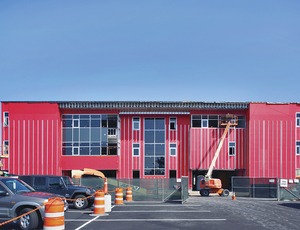Long Beach High School's $29-million renovation and expansion project was made possible thanks to the school district's ability to get voter approval of a $92.7-million bond referendum in 2009. But getting school bond approval during the recession was—and still is—a difficult feat for most schools, finance and construction industry experts say.


With the economy still stressed and the unemployment rate still high, "it's a difficult time to go to voters to ask them to approve a program that's eventually going to raise their taxes," says Robert Kerr, chairman of New York Municipal Advisors Corp., Syosset, N.Y.
It was "a little bit easier" to do this before the recession, says Kerr, whose firm advises municipalities and school districts, including the Long Beach City School District (LBCSD), on debt issuance. "Ten years ago the economy was doing well. New York state was giving incentives to school districts to do building projects and to improve their building plans," he says. About half of New York state's school districts had some sort of capital project in the works, he adds.
But the recession dried up what little activity there was, and many schools put even their maintenance projects on hold. As a result, it is mostly the patch-and-repair projects that are undertaken, and they are largely funded via a district's annual capital budget or through small-bond referendums, some in the low million-dollar range or less, says Roger Smith, principal of BBS Architects and Engineers, Patchogue, N.Y., whose firm assists school districts with capital bond referendums.
"So if there's a crack in the facade of a 60-year-old building, they're fixing the crack, not [addressing] the whole problem," Smith says. "People are doing just the complete necessities."
Even so, the number of school construction projects has not dramatically declined, although the size of these projects has. "What the economy has done is not only reduce the amount of work that is out there, but also reduce the magnitude of the projects, so [repair and infrastructure reconstruction work] are being pushed out and deferred," Smith says. "The future is going to be work that preserves the integrity of infrastructure and work that supports curriculum," such as upgrading science rooms.
Despite the tough climate for school bond referendums, some districts have been able to convince taxpayers to move forward, Kerr says.
That was ultimately the case in October 2011 for the Riverhead Central School District (RCSD), another Long Island town, located farther east. It took two tries, but RCSD was able to get a $78.3-million bond issue passed for expansions, renovations and infrastructure improvements at seven schools and a main campus.
The district had initially tried and failed to pass a $122-million proposal in February 2010, but after revising its capital improvement program, it resubmitted the lower-priced proposal and succeeded in getting it passed. BBS assisted RCSD in presenting the bond issue to voters. The district began the construction project during the summer.
"School construction is a huge portion of overall construction," says Smith, whose firm undertook $1.6 billion of Long Island's roughly $3 billion worth of school construction projects from 1998 through 2010. Smith estimates the value of Long Island's biddable construction work this year at about $125 million. "Districts are not doing the work," he says.
School districts also face a separate concern—the New York state mandatory 2% property-tax cap, which became effective for the first time with their 2012-2013 budgets. The cap limits annual growth of property taxes levied by local governments and school districts, says Tim Hoefer, director of the Empire Center for New York State Policy, an Albany-based think tank. If a district stays within the 2% base cap, then it needs only a simple majority of voters to approve its budget. If, however, the district exceeds that tax cap, then its budget requires 60% voter approval. Thus, districts that exceed the cap need a greater level of voter approval to pass a proposed budget.
"There has been terrible confusion out there among the districts and the taxpayers," Smith says. When the measure was introduced last year, some believed that it applied to capital construction work. It took about nine months to better clarify that such work is outside of the tax cap, and some voters are still confused, he adds.
School bond referendums, however, are separate from the cap. Kerr says he does not expect many school districts to seek bond referendums in 2013. "It will take a couple more years than that," he says. "There's still economic pressure on the districts to stay within that tax levy, and the economy is not expected to improve much in 2013."
The irony, he adds, is that it is a good time for school districts to move ahead with improvement programs because construction costs are down and interest rates to finance capital projects are at historic lows. The interest rate on a 20-year, tax-exempt bond issue is currently under 3%.
As for investors, the relative safety of school district debt and the tax advantages of not paying income tax on the earnings are big pluses. "There's a lot of interest and, actually, the interest in this type of debt has grown due to its relative safety," Kerr says. Given that investors do not like the risk of lending to, for example, construction firms, school district bonds are a good place for them to park their money. "You don't hear about school districts filing for bankruptcy; it happens, but it's very rare," he says.
Meanwhile, the LBCSD bond, plus $6.2 million it already had on hand in emergency funds for exterior repairs, made its $98.9-million capital improvement plan a reality. The plan includes renovations and/or repairs to seven LBCSD schools plus some administrative buildings (table, p. 25).
Despite LBCSD's success in getting 59% of the 2,857 voters to approve the bond proposition on its first try, the current project plans are a scaled-back version of the proposal that the district had originally hoped to execute. Initially, a three-year master planning process had identified $350 million worth of projects in need of attention, says Michael DeVito, LBCSD chief operating officer.
School buildings, some of which date back to the 1920s and 1930s, had suffered from years of "insufficient funding in our operating budget to do the type of preventive maintenance and large-scale repairs that's really needed on these old buildings," DeVito says. "The first things to go in a [down economy] is this type of maintenance, so the district had deferred maintenance on its buildings."
At LBCSD, the school board decided that the $350-million price tag was too hefty for residents to consider, and so it downsized the plan. "They tried to look at the real priorities and bring it in line with a number that they felt the community could handle, so they decided on the $92.7-million bond." Under what they called the "school preservation plan," they outlined priorities around three operating principles: safety, community use and facilities preservation, DeVito says.
Although LBCSD voters approved the referendum in 2009, the district did not begin borrowing until May 2011, and it began repaying the debt six months later, he says. The district will repay the bond issue over 15 years at 3% interest, he adds. LBCSD also received $38.1 million in NYS Building Aid, a multiyear state reimbursement program, to help offset costs.
With the state aid, the average monthly payment for a homeowner with property value assessed at $673,200 will be about $19 a month. Convincing voters that that will be money well spent was not too difficult in the end, says Tom Ritzenthaler, executive principle at CS Arch, Albany, which began developing the long-range facilities plan for the district in 2007. His firm made many presentations to the public on behalf of the district, identifying specific infrastructure and safety repairs that were needed.
"There's a reason they call this a 'preservation' plan," Ritzenthaler says. Many of the district's old buildings were in bad condition, which was quite apparent to the parents and others who visited them. In one of the elementary schools, for example, the facade was in such distress that some of the masonry's steel lintels had fallen off, he says.
The hard part for the district was paring down the original plan to only the essentials that would preserve and upgrade the school, Ritzenthaler says. In this case, he adds, the easier part was getting voter approval because they had long recognized the need.





Post a comment to this article
Report Abusive Comment